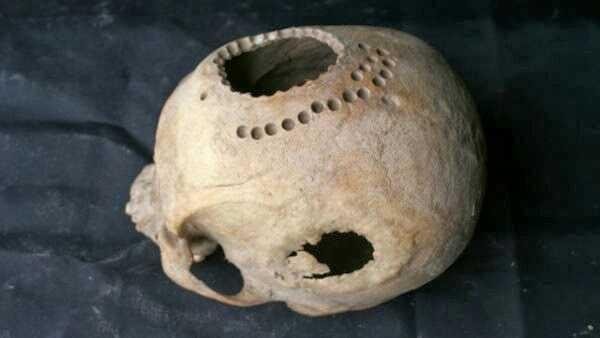Operation of Medieval Ancient Skulls Without Anesthesia
Surgery of tengkorang is still considered a difficult thing, where the physical effects can be carried from antiseptic, special surgical tool and excessive medication to reduce pain.
But surprising recent evidence has recently been found, Peru's healing practice involves removing the upper part of the skull using a hand drill or scratch tool about 1000 years ago.
An ancient skull operating technique that ran past Peru in the past to treat a variety of ailments, from head injuries to heart disease, and they performed the operation without the use of anesthetic drugs.
Can we imagine, skull surgery and heart surgery without busting, one stitch on the skin maybe everyone can barely bear the pain.
#Trepanation, Medieval Skull Opening
Archaeological Bio team led by Danielle Kurin of UC Santa Barbara, in her research dug up the remains of 32 fossil people who had lived in the late middle century (1000 to 1250 AD), the fossil is located in a cemetery cavern located in the southern Andean province of Andahuaylas, Peru.
Among the fossils found, as many as 45 separate procedures from the evidence collected.
Described in the middle ages, when a person suffers head injuries that cause swelling and is considered dangerous or has neurological, spiritual or psychosomatic diseases, drilling in cranial operations is a natural thing both then and now.
According to Kurin, the technique of skull operation was first discovered in the highlands of the southern Andes during the early medieval times, around 200 to 600 AD.
Although the technique was not entirely practiced in society, it was considered a viable medical procedure until Spain was present in the 16th century.
The area dug by the Kurin team is thought to be a mysterious kingdom region known as Wari.
The possibility of this kingdom is still developing in the year 400 to 1000 AD, and no exact reason why the kingdom suddenly collapsed, allegedly civilization brought a big problem for the immigrants.

It was precisely at the time of the destruction, the team of scientists saw evidence of a strong medical defense on the Moxie people.
They use the medical system in the same way, the wounds caused by the civil war led to better medical development.
So the Peruvians used the trebanation or ancient skull operation to face new challenges in the next century, diaman in 1000 AD there was a very heavy situation (violence and disease spread).
Kurin and his team consider that the practice of cutting practitioners used around the century using a scratch, some that look like using a cutter, and utilizing a hand drill.
In another analysis they allegedly used different techniques, experiments to get the best pieces of the skull.
This success is sometimes good, and sometimes not as expected.
When a patient fails to survive during the operation of the skull or afterwards, then perhaps he has become a contributor to science.
The fossil found estimates that ancient skull surgery can lift a special part of the head and without touching a part of the brain, surely it requires special skills such as surgeons today.
Some assumptions suggest that the hole at the top of the head (trepanation) is a form of torture, but the Kurin team estimates it is not.
They recognize the presence of hair shaving, a black stain caused by herbal remedies that are usually placed over the wound.
All of this is considered as a sign that the purpose of ancient cranial operations to save humans.
the remains of the fossils that Kurin found today are mostly studied, some of the skull findings have also been collected by archaeologists earlier, and are in the Smithsonian Institution Museum, the Field Museum of Natural History or the Hearst Museum of Anthropology.
This archaeological excavation analyzes medically from the human skeleton, wherein the Kurin team has known exactly how, when and how to find the grave, as well as anyone buried there.
The study used radiocarbon dating and insect casing to determine how long the corpse was left before it became a mummy.
And multi isotope testing to reconstruct whatever is eaten and where they are born.
Scientists consider, the age of darkness that brought down civilization at that time actually creates medical resilience and generate new innovations, especially in terms of ancient skull operations.1. item
Nice posting..
Congratulations @cutkurata! You have completed some achievement on Steemit and have been rewarded with new badge(s) :
Click on any badge to view your own Board of Honor on SteemitBoard.
To support your work, I also upvoted your post!
For more information about SteemitBoard, click here
If you no longer want to receive notifications, reply to this comment with the word
STOPDo not miss the last announcement from @steemitboard!
This post has received a 0.32 % upvote from @booster thanks to: @cutkurata.